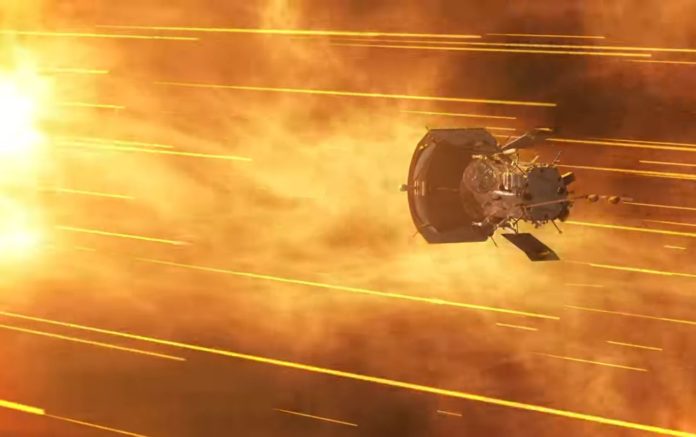NASA’s robotic station for the first time passed through one of the layers of the Sun’s atmosphere – the corona.
NASA’s Parker Solar Probe “touched” the Sun for the first time.
NASA’s Parker Solar Probe has now collected particles and magnetic fields in the Sun’s upper atmosphere, known as the corona.
TThe latest achievement is a huge step forward for the Parker Solar Probe and a giant leap forward towards solar science. Touching the same stuff the Sun is made of will help scientists unearth crucial knowledge about our closest star and its influence on the solar system, just as landing on the Moon allowed scientists to understand how it was formed.
“Parker Solar Probe “touching the Sun” is a monumental moment for solar science and a truly remarkable feat,” says Thomas Zurbuchen, Science Mission Directorate at NASA Headquarters in Washington.
“Not only does this milestone provide us with deeper insights into our Sun’s evolution and it’s impacts on our solar system, but everything we learn about our own star also teaches us more about stars in the rest of the universe.”
Parker is revealing scientific breakthroughs that other spacecraft couldn’t observe because they were too far away, including from within the solar wind, which is the flow of particles from the Sun that can affect us on Earth.
Parker revealed in 2019 that magnetic zig-zag formations in the solar wind, known as switchbacks, are abundant near the Sun. However, it remained a mystery as to how and where they formed.
Parker Solar Probe has now traveled close enough to identify one spot where they originate: the solar surface, after halving the distance to the Sun since then.
“The new milestone marks one major step for the Parker Solar Probe and one giant leap in solar science. Just as the moon landing allowed scientists to understand how it formed, touching the material that makes up the sun will help scientists uncover important information. about our nearest star and its effect on the solar system, “the agency added.
Parker Solar Probe was launched in 2018 with the goal of delving deeper into the secrets of the Sun by journeying closer to it than any previous spacecraft. Parker has finally come three years after its introduction and decades after its creation.
The Sun, unlike Earth, does not have a solid surface. It does, however, have a superheated atmosphere made of solar material that is gravitationally and magnetically bonded to the Sun. As the material is pushed away from the Sun by increased heat and pressure, it reaches a point where gravity and magnetic fields are no longer strong enough to retain it.
The end of the solar atmosphere and the start of the solar wind are marked by the Alfvén critical surface. Solar material having enough energy to pass that limit creates the solar wind, which carries the Sun’s magnetic field with it as it speeds through the solar system to Earth and beyond. Importantly, the solar wind moves so fast beyond the Alfvén critical surface that waves inside the wind can never travel fast enough to return to the Sun, severing their connection.
Researchers had no idea where the Alfvén critical surface was until now. Estimates based on remote views of the corona put it between 10 and 20 solar radii – 4.3 to 8.6 million miles – from the Sun’s surface. Parker’s spiral trajectory pushes it closer to the Sun with time, and over the past few visits, it was continuously below 20 solar radii (91 percent of Earth’s distance from the Sun), putting it in position to breach the threshold — assuming the estimations were true.
Parker Solar Probe encountered specific magnetic and particle conditions at 18.8 solar radii (around 8.1 million miles) above the solar surface on April 28, 2021, during its eighth flyby of the Sun, indicating it had crossed the Alfvén critical surface for the first time and finally entered the solar atmosphere.
“We were fully expecting that, sooner or later, we would encounter the corona for at least a short duration of time,” adds Justin Kasper, lead author on a new paper.
“But it is very exciting that we’ve already reached it.”
Parker Solar Probe flew into and out of the corona many times throughout the flyby. This shows that the Alfvén critical surface is not shaped like a smooth ball, as some had assumed. Rather, the surface is wrinkled by spikes and troughs.
Scientists will be able to learn more about how events on the Sun affect the atmosphere and solar wind if they can figure out where these protrusions line up with solar activity coming from the surface.
“It’s really exciting to see our advanced technologies succeed in taking Parker Solar Probe closer to the Sun than we’ve ever been, and to be able to return such amazing science,” says Joseph Smith, Parker program executive at NASA Headquarters. “We look forward to seeing what else the mission discovers as it ventures even closer in the coming years.”
Source: NASA
You were reading: Parker Solar Probe touches the Sun for the first time
